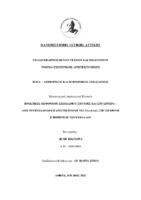| dc.contributor.advisor | Sinou, Maria | |
| dc.contributor.author | Δελή, Βικτώρια | |
| dc.date.accessioned | 2022-07-18T06:27:36Z | |
| dc.date.available | 2022-07-18T06:27:36Z | |
| dc.date.issued | 2022-07-06 | |
| dc.identifier.uri | https://polynoe.lib.uniwa.gr/xmlui/handle/11400/2513 | |
| dc.identifier.uri | http://dx.doi.org/10.26265/polynoe-2353 | |
| dc.description.abstract | Η παρούσα έρευνα μελετά την παραδοσιακή αρχιτεκτονική και συγκεκριμένα την Κυκλαδίτικη αρχιτεκτονική εστιάζοντας στις αμιγώς λίθινες κατασκευές. Το βασικό ερώτημα είναι αν η παραδοσιακή αρχιτεκτονική χρησιμοποιούσε πρακτικές αειφορικού σχεδιασμού, αν πρόσφερε στους χρήστες της συνθήκες άνετης διαβίωσης / βιώσιμου περιβάλλοντος, δεδομένου ότι αναφερόμαστε σε πολλά χρόνια πίσω, χωρίς ιδιαίτερες τεχνολογικές γνώσεις και τι σχέση τελικά υπάρχει με τις σύγχρονες πρακτικές αειφορικού σχεδιασμού.
Με βάση τα κλιματολογικά δεδομένα, το ανάγλυφο, τη μορφολογία της περιοχής ερευνούμε τις πρακτικές αειφορικού σχεδιασμού μέσα από την τυπολογία των σπιτιών και την χωροθέτηση των χώρων σε σχέση με τον προσανατολισμό, τα υλικά και τον τρόπο κατασκευής (κέλυφος, τοιχοποιία, δώμα ), τον φωτισμό, τον αερισμό, τον ηλιασμό, τον δροσισμό, την συλλογή νερού, την βλάστηση - τοπική ξυλεία, κλπ.
Από την παραπάνω έρευνα και σε συνδυασμό με τις νέες μεθόδους βιοκλιματικού σχεδιασμού καταλήγουμε σε σύγκριση των πρακτικών αειφορικού σχεδιασμού της παραδοσιακής αρχιτεκτονικής με την σύγχρονη και στο τελικό συμπέρασμα ότι η οι σημερινές πρακτικές είναι συνέχεια της παραδοσιακής, ότι έχουν τις ρίζες τους σε παλιές μεθόδους. Η παραδοσιακή αρχιτεκτονική αλλά και οι πρακτικές της αποτελούν την βάση, την συνέχεια και φυσικά είναι η εξέλιξη των σύγχρονων πρακτικών. | el |
| dc.format.extent | 110 | el |
| dc.language.iso | el | el |
| dc.publisher | Πανεπιστήμιο Δυτικής Αττικής | el |
| dc.rights | Αναφορά Δημιουργού - Μη Εμπορική Χρήση - Παρόμοια Διανομή 4.0 Διεθνές | * |
| dc.rights.uri | https://creativecommons.org/licenses/by-nc-sa/4.0/deed.el | * |
| dc.subject | Κυκλάδες | el |
| dc.subject | Βλάστηση και τοπική ξυλεία | el |
| dc.subject | Παραδοσιακή αρχιτεκτονική | el |
| dc.subject | Παραδοσιακό σπίτι | el |
| dc.subject | Βιοκλιματικός σχεδιασμός | el |
| dc.subject | Πρακτικές αειφορικού σχεδιασμού | el |
| dc.title | Πρακτικές αειφορικού σχεδιασμού στο χθες και στο σήμερα – Από την παραδοσιακή αρχιτεκτονική της Ελλάδας στη σύγχρονη. Η περίπτωση των Κυκλάδων. | el |
| dc.title.alternative | Sustainable methods of design in the past and the present - From traditional Greek architecture to the modern one. The case of Cyclades. | el |
| dc.type | Μεταπτυχιακή διπλωματική εργασία | el |
| dc.contributor.committee | Bobolos, Nicos | |
| dc.contributor.committee | Μοίρα, Μαρία | |
| dc.contributor.faculty | Σχολή Εφαρμοσμένων Τεχνών & Πολιτισμού | el |
| dc.contributor.department | Τμήμα Εσωτερικής Αρχιτεκτονικής | el |
| dc.contributor.master | Αρχιτεκτονική Εσωτερικών Χώρων: Αειφορικός και Κοινωνικός Σχεδιασμός | el |
| dc.description.abstracttranslated | This specific research studies the traditional architecture, especially the Cycladic one focusing on the purely stone constructions. The main question is whether the traditional architecture used sustainable design practices, if it offered comfortable living conditions / sustainable surroundings to its users, based on the fact that we refer to many years ago, without any specific technological knowledge and what the relationship with the modern practices of sustainable design is.
Based on the climate conditions, the relief, the geographical features of the region we study the sustainable design practices via the house typology and the space positioning in relation with the orientation, the materials, and the way of the construction (shell, masonry, loft apartment) the lighting, the ventilation, the solarisation, the cooling, the water gathering, the vegetation, the local timber etc.
Taking into account the above- mentioned study along with the new methods of bioclimatic design we end up comparing the sustainable design practices of the traditional architecture with the modern one, and also in the final conclusion that today’s practices are the continuity of the traditional ones and that they have their roots in the old methods. The traditional architecture as well as its practices constitute the basis, the continuity and the evolution of the modern ones. | el |


